November 2022
Your Feet Get You Places
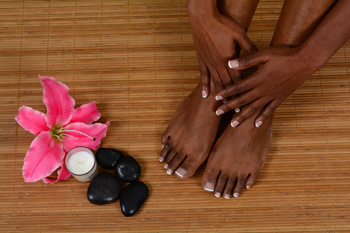
Given how much work our feet do for us in getting places in life, it stands to reason that we should take care of them well. Feet that look good generally feel good. Going barefoot can lead to injuries, especially if done so on hard surfaces. It is better to wear cushioned sandals or slippers when indoors. Choosing the right footwear is imperative in taking care of your feet. It is important to wear supportive shoes designed for the activity undertaken. One would not want to wear tennis shoes for running or high heels for working or standing for prolonged periods. When shoe shopping, cushioning, arch support, and shock absorption are key factors to look for. The shape of the shoe should also match the shape of the foot, and shoes should be comfortable from the moment they are tried on. Assess the soles of the shoes to examine unevenness as well as wear and tear, and replace shoes when necessary. Check your feet regularly and gift yourself pedicures and foot massages as key ways to relax the feet and care for them. If you have problems with your feet, do not self-diagnose. Instead, visit a podiatrist who can examine your feet and catch and treat anything that goes amiss.
Everyday foot care is very important to prevent infection and other foot ailments. If you need your feet checked, contact Dawn Miles, DPM from Florida. Our doctor can provide the care you need to keep you pain-free and on your feet.
Everyday Foot Care
Often, people take care of their bodies, face and hair more so than they do for their feet. But the feet are a very important aspect of our bodies, and one that we should pay more attention to. Without our feet, we would not be able to perform most daily tasks.
It is best to check your feet regularly to make sure there are no new bruises or cuts that you may not have noticed before. For dry feet, moisturizer can easily be a remedy and can be applied as often as necessary to the affected areas. Wearing shoes that fit well can also help you maintain good foot health, as well as making it easier to walk and do daily activities without the stress or pain of ill-fitting shoes, high heels, or even flip flops. Wearing clean socks with closed shoes is important to ensure that sweat and bacteria do not accumulate within the shoe. Clean socks help to prevent Athlete’s foot, fungi problems, bad odors, and can absorb sweat.
If you have any questions please feel free to contact one of our offices located in Palatka and Saint Augustine, FL . We offer the newest diagnostic and treatment technologies for all your foot and ankle needs.
Women May Develop Hammertoe More Frequently Than Men
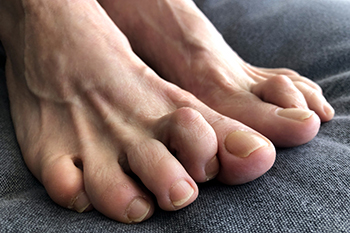
Hammertoe is considered to be a deformity. It is a foot condition that usually affects the 2nd, 3rd, or 4th toes, and causes them to bend downward at the joint. This can resemble a hammer, hence the name. Wearing shoes that do not have ample room for the toes to move freely may be a top reason why hammertoe occurs. Research has shown women are more prone to developing hammertoes and this may be the result of wearing high heels that have pointed toes. In the beginning stages, the toes may remain flexible and it is somewhat reasonable that they can be manipulated into their normal position. In more severe cases, corns may develop on top of the toes from friction as the toes rub that portion of the shoe. Additionally, there may be medical conditions that can lead to the onset of hammertoe, including rheumatoid arthritis, peripheral neuropathy, and inflammatory joint diseases. If you are afflicted with hammertoe, please consult with a podiatrist who can determine its severity and offer the correct treatment options.
Hammertoes can be a painful condition to live with. For more information, contact Dawn Miles, DPM of Florida. Our doctor will answer any of your foot- and ankle-related questions.
Hammertoe
Hammertoe is a foot deformity that occurs due to an imbalance in the muscles, tendons, or ligaments that normally hold the toe straight. It can be caused by the type of shoes you wear, your foot structure, trauma, and certain disease processes.
Symptoms
- Painful and/or difficult toe movement
- Swelling
- Joint stiffness
- Calluses/Corns
- Physical deformity
Risk Factors
- Age – The risk of hammertoe increases with age
- Sex – Women are more likely to have hammertoe compared to men
- Toe Length – You are more likely to develop hammertoe if your second toe is longer than your big toe
- Certain Diseases – Arthritis and diabetes may make you more likely to develop hammertoe
Treatment
If you have hammertoe, you should change into a more comfortable shoe that provides enough room for your toes. Exercises such as picking up marbles may strengthen and stretch your toe muscles. Nevertheless, it is important to seek assistance from a podiatrist in order to determine the severity of your hammertoe and see which treatment option will work best for you.
If you have any questions, please feel free to contact one of our offices located in Palatka and Saint Augustine, FL . We offer the newest diagnostic and treatment technologies for all your foot care needs.
Where Is the Tarsal Tunnel?
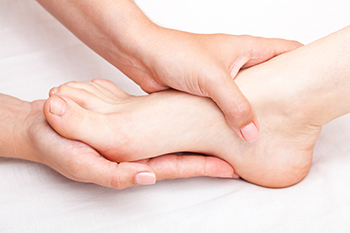
The feet endure hundreds of times the body weight of an individual, occurring several times per day. The ankle is responsible for weight bearing, in addition to absorbing the shock, the body endures while walking and running. One of the components of the ankle is called the tarsal tunnel, and the tibial nerve is located inside this tunnel. The foot condition that is known as tarsal tunnel syndrome occurs when the tibial nerve becomes inflamed and compressed, and can cause difficulty in walking. This condition may be prone to people who have flat feet, as a result of abnormal foot structure. Additionally, a tumor or cyst that has developed in this part of the foot may place pressure on the nerve, possibly causing tarsal tunnel syndrome to develop. Common symptoms patients may experience may consist of a burning sensation along the inside of the ankle, and can radiate to the entire foot. Relief may be found when the affected foot is elevated, and walking can temporarily subside. Effective prevention methods may include performing specific stretches that can strengthen the ankle, in addition to warming up and cooling down before and after running. Tarsal tunnel syndrome is treated by a podiatrist, and it is suggested that you confer with this type of doctor who can offer you the correct treatment options.
Tarsal tunnel syndrome can be very uncomfortable to live with. If you are experiencing tarsal tunnel syndrome, contact Dawn Miles, DPM of Florida. Our doctor can provide the care you need to keep you pain-free and on your feet.
Tarsal Tunnel Syndrome
Tarsal tunnel syndrome, which can also be called tibial nerve dysfunction, is an uncommon condition of misfiring peripheral nerves in the foot. The tibial nerve is the peripheral nerve in the leg responsible for sensation and movement of the foot and calf muscles. In tarsal tunnel syndrome, the tibial nerve is damaged, causing problems with movement and feeling in the foot of the affected leg.
Common Cause of Tarsal Tunnel Syndrome
- Involves pressure or an injury, direct pressure on the tibial nerve for an extended period of time, sometimes caused by other body structures close by or near the knee.
- Diseases that damage nerves, including diabetes, may cause tarsal tunnel syndrome.
- At times, tarsal tunnel syndrome can appear without an obvious cause in some cases.
The Effects of Tarsal Tunnel Syndrome
- Different sensations, an afflicted person may experience pain, tingling, burning or other unusual sensations in the foot of the affected leg.
- The foot muscles, toes and ankle become weaker, and curling your toes or flexing your foot can become difficult.
- If condition worsens, infections and ulcers may develop on the foot that is experiencing the syndrome.
A physical exam of the leg can help identify the presence of tarsal tunnel syndrome. Medical tests, such as a nerve biopsy, are also used to diagnose the condition. Patients may receive physical therapy and prescriptive medication. In extreme cases, some may require surgery.
If you have any questions please feel free to contact one of our offices located in Palatka and Saint Augustine, FL . We offer the newest diagnostic and treatment technologies for all your foot and ankle needs.
Reasons for Pain in the Ball of the Foot
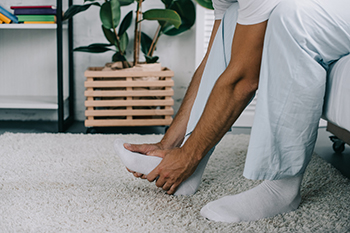
If you have pain in the ball of your foot, it may be medically referred to as metatarsalgia. The bones that connect the ankle to the toes are called the metatarsals and can become painful from standing or walking for most of the day. Additional reasons this type of pain may occur include having arthritis and wearing shoes that are not supportive. Foot pain can be noticeable in different forms, including a burning sensation and numbness in the toes. Additionally, the feeling of a small pebble or marble on the sole of the foot can indicate the condition that is known as Morton’s neuroma, which may cause difficulty in walking. There are effective prevention methods that can be implemented which may reduce foot pain. Resting and elevating the feet is often successful in alleviating this foot pain. It is also a good idea to change the shoes that are worn each day. Foot pain of any kind indicates that a visit to the podiatrist may be necessary, so please contact this type of doctor as quickly as possible who can help you with any type of foot pain you may have.
Foot Pain
Foot pain can be extremely painful and debilitating. If you have a foot pain, consult with Dawn Miles, DPM from Florida. Our doctor will assess your condition and provide you with quality foot and ankle treatment.
Causes
Foot pain is a very broad condition that could be caused by one or more ailments. The most common include:
- Bunions
- Hammertoes
- Plantar Fasciitis
- Bone Spurs
- Corns
- Tarsal Tunnel Syndrome
- Ingrown Toenails
- Arthritis (such as Gout, Rheumatoid, and Osteoarthritis)
- Flat Feet
- Injury (from stress fractures, broken toe, foot, ankle, Achilles tendon ruptures, and sprains)
- And more
Diagnosis
To figure out the cause of foot pain, podiatrists utilize several different methods. This can range from simple visual inspections and sensation tests to X-rays and MRI scans. Prior medical history, family medical history, and any recent physical traumatic events will all be taken into consideration for a proper diagnosis.
Treatment
Treatment depends upon the cause of the foot pain. Whether it is resting, staying off the foot, or having surgery; podiatrists have a number of treatment options available for foot pain.
If you have any questions, please feel free to contact one of our offices located in Palatka and Saint Augustine, FL . We offer the newest diagnostic and treatment technologies for all your foot care needs.
Wounds That Don't Heal Need to Be Checked
Why Does Morton’s Neuroma Develop?
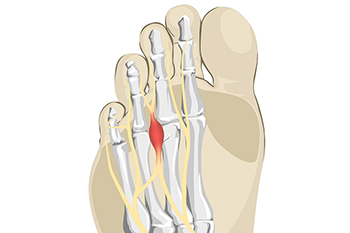
Nerve tissue between the third and fourth toes that becomes thick, or compressed, may indicate a condition known as Morton’s neuroma. It happens when there is not enough room for the toes to move freely in from wearing certain types of shoes. High heels fall into this category, and may cause the nerve to become irritated and inflamed. It is considered to be a painful foot condition, and relief may be found when different shoes are worn. This may be a successful treatment method if it is noticed early, and completing daily activities with ease may resume. In severe cases, where walking becomes difficult, surgery may be a necessary option for permanent relief by removing the affected nerve. The symptoms that many people can experience with this condition include the sensation of standing on a pebble or marble, and pain may radiate from the ball of the foot. Morton’s neuroma is a serious foot condition, and if you have any of the above symptoms, it is strongly advised that you are under the care of a podiatrist who can help you to find permanent relief.
Morton’s neuroma is a very uncomfortable condition to live with. If you think you have Morton’s neuroma, contact Dawn Miles, DPM of Florida. Our doctor will attend to all of your foot care needs and answer any of your related questions.
Morton’s Neuroma
Morton's neuroma is a painful foot condition that commonly affects the areas between the second and third or third and fourth toe, although other areas of the foot are also susceptible. Morton’s neuroma is caused by an inflamed nerve in the foot that is being squeezed and aggravated by surrounding bones.
What Increases the Chances of Having Morton’s Neuroma?
- Ill-fitting high heels or shoes that add pressure to the toe or foot
- Jogging, running or any sport that involves constant impact to the foot
- Flat feet, bunions, and any other foot deformities
Morton’s neuroma is a very treatable condition. Orthotics and shoe inserts can often be used to alleviate the pain on the forefront of the feet. In more severe cases, corticosteroids can also be prescribed. In order to figure out the best treatment for your neuroma, it’s recommended to seek the care of a podiatrist who can diagnose your condition and provide different treatment options.
If you have any questions, please feel free to contact one of our offices located in Palatka and Saint Augustine, FL . We offer the newest diagnostic and treatment technologies for all your foot care needs.










